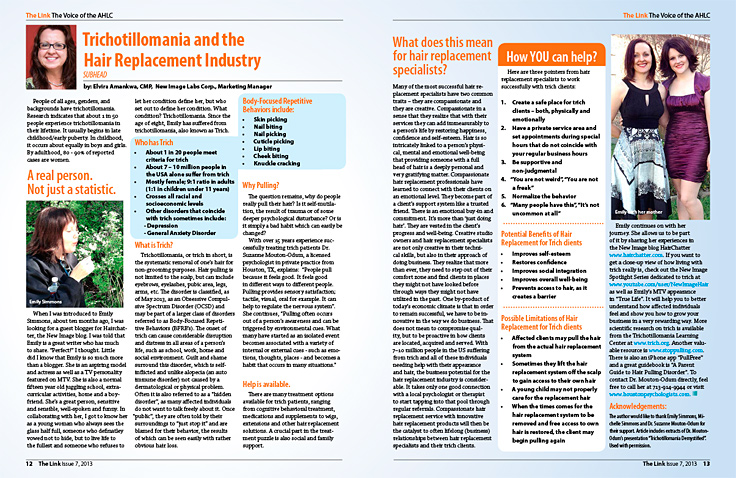The Link Issue 7, 2013: Trichotillomania and the Hair Replacement Industry
by: Elvira Amankwa, CMP, New Image Labs Corp
People of all ages, genders, andbackgrounds have trichotillomania. Research indicates that about 1 in 50 people experience trichotillomania in their lifetime. It usually begins in late childhood/early puberty. In childhood, it occurs about equally in boys and girls. By adulthood, 80 – 90% of reported cases are women.
When I was introduced to Emily Simmons, about ten months ago, I was looking for a guest blogger for Hairchatter, the New Image blog. I was told that Emily is a great writer who has much to share. “Perfect!” I thought. Little did I know that Emily is so much more than a blogger. She is an aspiring model and actress as well as a TV personality featured on MTV. She is also a normal fifteen year old juggling school, extracurricular activities, home and a boyfriend. She’s a great person, sensitive and sensible, well-spoken and funny. In collaborating with her, I got to know her as a young woman who always sees the glass half full, someone who definatley vowed not to hide, but to live life to the fullest and someone who refuses to let her condition define her, but who set out to define her condition. What condition? Trichotillomania. Since the age of eight, Emily has suffered from trichotillomania, also known as Trich.
Who has Trich
- About 1 in 20 people meet criteria for trich
- About 7 – 10 million people in the USA alone suffer from trich
- Mostly female; 9:1 ratio in adults (1:1 in children under 11 years)
- Crosses all racial and socioeconomic levels
- Other disorders that coincide with trich sometimes include:
- Depression
- General Anxiety Disorder
What is Trich?
Trichotillomania, or trich in short, is the systematic removal of one’s hair for non-grooming purposes. Hair pulling is not limited to the scalp, but can include eyebrows, eyelashes, pubic area, legs, arms, etc. The disorder is classified, as of May 2013, as an Obsessive Compulsive Spectrum Disorder (OCSD) and may be part of a larger class of disorders referred to as Body-Focused Repetitive Behaviors (BFRB’s). The onset of trich can cause considerable disruption and distress in all areas of a person’s life, such as school, work, home and social environment. Guilt and shame surround this disorder, which is selfinflicted and unlike alopecia (an auto immune disorder) not caused by a dermatological or physical problem. Often it is also referred to as a “hidden disorder”, as many affected individuals do not want to talk freely about it. Once “public”, they are often told by their surroundings to “just stop it” and are blamed for their behavior, the results of which can be seen easily with rather obvious hair loss.
Read full article here


